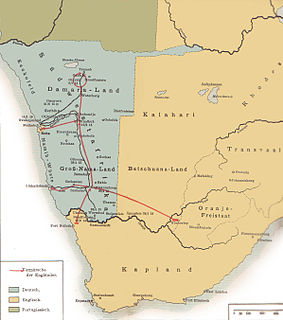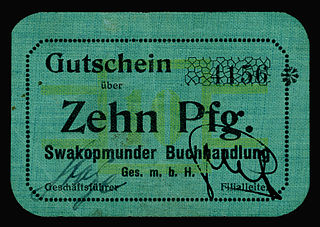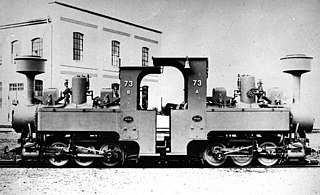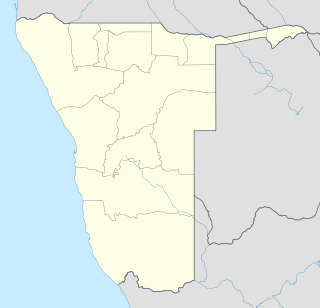This page is based on this
Wikipedia article Text is available under the
CC BY-SA 4.0 license; additional terms may apply.
Images, videos and audio are available under their respective licenses.

The Namibia dollar has been the currency of Namibia since 1993. It is normally abbreviated with the dollar sign $, or alternatively N$ to distinguish it from other dollar-denominated currencies. It is divided into 100 cents.

The South West Africa Campaign was the conquest and occupation of German South West Africa (Namibia) by forces from the Union of South Africa acting on behalf of the British Imperial Government at the beginning of the First World War.
The Mark was the currency of German South West Africa between 1885 and 1915. Until 1914, the German Mark circulated. Within days of the outbreak of the First World War, an issue of paper money titled Deutsch-Südwestafrikanische Mark was authorized in denominations of 5, 10, 20, 50 and 100 Marks.

TransNamib is the railway State-owned enterprise of Namibia. Organised as a holding company, it provides freight by rail and road as well as passenger services. Its administration is located in Windhoek.

Banknotes were issued by the Swakopmund Bookshop between 1916 and 1918 as an emergency currency. They issued 10, 25, 50 Pfennig, and 1, 2, and 3 mark notes. Although these were issued under South African administration, these notes are denominated in Pfennig and Mark, which was the South West African mark as opposed to the German South-West African Mark. Despite this, these are genuine British Empire and Commonwealth issues.

The South-West African mark was a temporary currency issued between 1916 after the withdrawal of the German South-West African mark, and prior to the introduction of the South African pound in 1918.
Volkskas Beperk was a South African bank founded in 1934 as a cooperative loan bank, becoming a commercial bank in 1941. In 1991, by which time it had become South Africa's largest Afrikaner bank, Volkskas merged with United Building Society, Allied Building Society and Trust Bank to form Amalgamated Banks of South Africa.
Banknotes were issued by Volkskas Limited between 1949 and 1959 from its Windhoek branch. The notes are quite scarce.

Windhoek railway station is a railway station serving the city of Windhoek, the capital of Namibia. It is an important station in the Namibian rail network, and it is run by TransNamib.

The South West African Zwillinge 0-6-0T of 1898 was a narrow gauge steam locomotive from the German South West Africa era.

Legislative elections were held for the first time in the territory of South West Africa on 26 May 1926. The German League in South West Africa won eight of the twelve elected seats in the Whites-only election.

Legislative elections were held in South West Africa on 3 July 1929. The whites-only election saw a victory for the United National South West Party, which won seven of the twelve elected seats in the Legislative Assembly.

Legislative elections were held in South West Africa on 31 October 1934. The whites-only election saw a victory for the United National South West Party, which won eight of the twelve elected seats in the Legislative Assembly.

Legislative elections were held in South West Africa on 21 February 1940. The whites-only election saw a victory for the United National South West Party, which won 10 of the 12 elected seats in the Legislative Assembly.

Legislative elections were held in South West Africa on 30 August 1950. The whites-only election saw a victory for the National Party of South West Africa, which won 15 of the 18 seats in the Legislative Assembly.

Legislative elections were held in South West Africa on 19 May 1945. The whites-only election saw a victory for the United National South West Party, which won all 12 elected seats in the Legislative Assembly.

The history of rail transport in Namibia began with a small mining rail line at Cape Cross in 1895. The first major railway project was started in 1897 when the German Colonial Authority built the 600 mm gauge Staatsbahn from Swakopmund to Windhoek. By 1902 the line was completed.

The South Sudanese pound is the official currency of the Republic of South Sudan. It is subdivided into 100 piasters. It was approved by the Southern Sudan Legislative Assembly before secession on 9 July 2011 from Sudan. It was introduced on 18 July 2011, and replaced the Sudanese pound at par.
After 28 years without a postal code system in Namibia, the postal service provider NamPost introduced new postal codes in December 2018.














